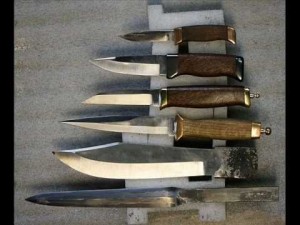I’ve liked knives ever since I was a kid.
I’m not a knife collector, per se, or a true knife aficionado. I don’t have expensive blades in cases, swords on the walls or a subscription to Blade Magazine. (Though now that I check out their website… NO… must… resist…)
Anyhow – I’m a gardener. Gardeners are generally practical and utilitarian. As much as I may totally dig a knife like this:

…I don’t need it.
Wonderful piece of work… but the price tag is prohibitive.
I own a variety of knives, ranging from vintage bayonets to meat cleavers, but today I’m going to share with you the knives that I’ve found most useful in my homesteading and camping ventures. I’m not a knife expert, but these are good survival knives I use regularly and would want to take with me.
As always, I welcome any additional comments on:
A: Why I’m a Moron Who Will Get People Killed When TSHTF
and
B: What Your Favorite Knives Are
I like “B” better, but A is fine too. We’re in this together and whereas I am a gardening expert, I’m not an expert on everything. There are plenty of people more knowledgeable than myself… you’re probably one of them.
With that in mind, here’s my list of go-to knives.
The Machete
Machetes are one of my very top tools. I use them extensively to clear brush, clear spiderwebs and beat the brush for snakes (NOT to cut them up – I like snakes!), slice up plants to add to the compost, and for doing “chop n’ drop” in my food forest.
They’re also excellent for beheading chickens.
My very favorite style of machete is known as a “cane machete,” since they’re used in sugarcane fields. They have a flat end and a hook on the back, like this:
The heft of a cane machete is excellent and the hook comes in handy for pulling stalks and branches into your reach. When I have one without a hook, I miss it.
Some of the best-made machetes come from Ralpha Martindale and Company, which is a British manufacturer. I came in contact with their blades when I was traveling in the Caribbean (yes, I shop for gardening tools even on vacation) and they’re much better than most of what you get here in the states. Unfortunately, their machetes are hard to find. A good runner-up are the blades from Cold Steel.
Just don’t buy a Gerber machete. They’re complete trash. (I reviewed their “Gator” model here.)
Try a few machetes to see how you like their heft and handles. A machete should be able to be used for a long stretch of time without tiring you out. You’ll find a favorite model once you familiarize yourself with the tool.
The Fighting Knife
I’ve never been in combat, but I do have a few “fighting” knives in my collection. A veteran or gangster could probably give you a better recommendation on a good fighting/survival knife for the wild, but my favorite thus far is the Ka-Bar.
I use it for butchering, not fighting, much like folks would use a classic Buck knife.
A survival knife with a compass and matches in the handle might be a good stand-in, but I like the strength and simplicity of the Ka-Bar design. Plus… 5-star reviews on Amazon. Everyone likes this knife.
The Boning Knife
When you’re butchering meat, particularly small game, it’s good to have a small boning knife for detail work.
I use this knife for chickens, squirrel, raccoon, etc.:

It’s a J. A. Henckels 5.5″ boning knife. It keeps a good edge and is especially good for gutting fowl and separating small joints. Good steel makes a big difference.
The Pocketknife
When it comes to pocketknives, I like simple and well-made. My Grandpa always carried a Schrade “Old Timer,” so I have an affection for that model. Even though they’re no longer made in the US, the steel is good and the blades are solid. Plus they’re not expensive.

This is a good knife to carry when you’re in church, out and about or wearing dress clothes. It’s small and sharp and can cut cord, pare an apple or fix your fingernails.
I also use mine for grafting. The blades are small and sharp enough to do a good enough job that I don’t need to get a true grafting knife.
The Multitool
Multitools are like “knives plus.” Unlike a dedicated blade, they seek to meet the needs of a variety of tasks by packing a bunch of tiny tools into a small space.
My father-in-law bought me a Leatherman Wave a decade ago and the tool is still going strong.
Though it’s bulkier than a typical pocketknife, it’s also quite versatile. It also has a good heft and size for adding inertia to your fist.
When I was a kid I owned Swiss Army Knives… now I own this. It’s a well-built tool for grown-ups. They’re especially nice to keep in the car or to bring to a construction job. If you can’t find a screwdriver… or a saw… or a file… or a pair of scissors… the Leatherman fills in the gap. I’d definitely consider adding one – or something similar – to your bug-out bag.
Additional knives you might consider adding to your collection include a good lockback type, a filet knife for fish or a bowie knife for serious bushcrafting. As it is, with my homesteading and outdoors work, I’m pretty well set with these five good survival knives. They’re definitely a cut above the typical cheapo selections.
This article was originally published at Ready Nutrition™ on July 13th, 2014










